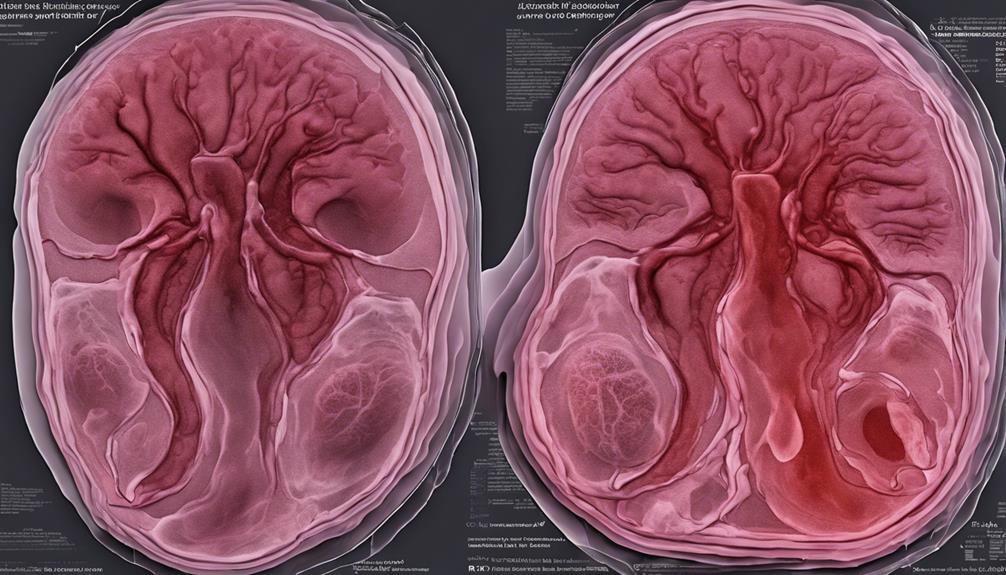The saying “knowledge is power” is particularly relevant when it comes to a third trimester ultrasound, as the information obtained can have a significant impact.
From the baby's growth and position to the placental health and potential complications, this scan offers a window into the well-being of both the baby and the pregnancy.
The information revealed during this ultrasound can be important for making informed decisions and ensuring the best possible outcome for the pregnancy.
So, what exactly can this ultrasound disclose in the important third trimester?
Key Takeaways
- Assess fetal growth and well-being for a healthy delivery.
- Determine baby's position to plan for a safe birth.
- Detect complications like abnormalities or placental issues.
- Evaluate placenta health and amniotic fluid levels for optimal fetal development.
Growth and Development Assessment
Evaluating the growth and development of the fetus in the third trimester through ultrasound enables tracking of length and weight measurements to monitor progress effectively. It's a time of anticipation and wonder, as we witness the miracle of life unfolding before our eyes.
The ultrasound reveals intricate details about fetal growth, including the estimated fetal weight, ensuring that our little one is thriving inside the womb. We can observe the levels of amniotic fluid, a crucial indicator of the baby's environment, and check for any signs of fetal abnormalities that may require attention.
Feeling the joy of fetal movement and seeing the umbilical cord blood flow in real-time fills us with gratitude and reassurance. Every beat of the heart and stretch of tiny limbs is a proof to the beauty of creation.
Through these moments of connection, we bond with our baby even before they enter the world, cherishing each milestone along this miraculous journey.
Baby's Position and Presentation

In the third trimester ultrasound, we can determine the baby's position in the uterus, providing essential information for planning the delivery process. This examination helps us identify the fetal position, whether the baby is in a cephalic (head down), breech, or transverse presentation.
Understanding the baby's position is critical as it allows healthcare providers to assess the feasibility of a vaginal delivery. In cases where there's abnormal positioning detected, such as breech or transverse presentations, interventions during birth may be necessary to guarantee a safe delivery for both the baby and the mother.
The information gathered from the ultrasound not only aids in determining the best course of action for delivery but also guides medical decisions to address any challenges that may arise during the birthing process. Being aware of the baby's position empowers us to make informed decisions and tailor the delivery plan to guarantee a smooth and safe birth experience.
Detection of Complications
Understanding the baby's position in the uterus during the third trimester ultrasound enables us to detect various complications that may affect the health of both the mother and the baby. This critical scan helps identify fetal abnormalities, placental issues, and conditions like fetal growth restriction, oligohydramnios, and placenta previa.
By evaluating amniotic fluid levels and looking for signs of cord compression, we can catch potential problems early on. The ultrasound also aids in recognizing fetal distress and the risk of macrosomia, a condition where the baby is larger than average. Additionally, it allows monitoring for concerns such as preeclampsia, fetal anomalies, and umbilical cord abnormalities.
Detecting these complications through the third trimester ultrasound is essential as it provides valuable insights that can impact the delivery process and the well-being of both the mother and the baby.
Placenta Health Evaluation

Evaluating the health of the placenta in the third trimester ultrasound is pivotal for ensuring the best nutrient and oxygen supply to the fetus. During this ultrasound, we focus on appraising the placenta's position, checking for any abnormalities like placenta previa, which could impact delivery.
Monitoring the placental blood flow using Doppler ultrasound helps us guarantee that the baby is receiving sufficient oxygen and nutrients for the best development. By appraising the placental health, we can also detect any blood clots that might hinder fetal well-being and growth.
This detailed examination of the placenta's health and function is critical in guaranteeing that it can adequately support the baby until birth. It allows us to intervene early if any issues are detected, ensuring the well-being of both the mother and the baby.
The third trimester ultrasound plays a significant role in safeguarding the health and development of the fetus by closely monitoring the placenta's condition.
Amniotic Fluid Levels Analysis
As we shift our focus to the amniotic fluid levels analysis in the third trimester ultrasound, our attention now turns to evaluating the environment surrounding the fetus in the womb. Monitoring the levels of amniotic fluid, whether it be polyhydramnios (excessive fluid) or oligohydramnios (low fluid), is essential for evaluating fetal well-being and development. Changes in these levels can indicate potential issues such as fetal growth problems or placental dysfunction, impacting the overall health and viability of the pregnancy. By accurately evaluating the amniotic fluid levels, healthcare providers can gather essential insights into the baby's environment and make informed decisions regarding the next steps in care.
| Amniotic Fluid Levels Analysis | |
|---|---|
| Polyhydramnios | Excessive amniotic fluid |
| Oligohydramnios | Low levels of amniotic fluid |
| Fetal well-being | Evaluation of baby's health |
| Fetal growth problems | Issues with baby's development |
| Pregnancy viability | Determining health of the pregnancy |
Frequently Asked Questions
What Are the Abnormalities in the Third Trimester Ultrasound?
We can identify abnormalities like fetal growth issues, amniotic fluid imbalances, abnormal fetal presentation, and placental problems during a third trimester ultrasound. It helps us detect potential concerns early, providing essential information for care.
What Are the Benefits of Ultrasound in the Third Trimester of Pregnancy?
In the third trimester, ultrasound benefits include evaluating fetal well-being, guiding medical decisions, and ensuring best outcomes for both mother and baby. It helps detect abnormalities, monitor growth, and evaluate fetal health.
What Can a 36 Week Ultrasound Tell You?
At 36 weeks, our ultrasound can reveal the baby's position, weight around 6 pounds, amniotic fluid levels, and confirm placental health. It captures detailed fetal images for abnormalities, aiding in preparing for a safe delivery.
What Do They Check at 32 Week Ultrasound?
At 32 weeks, we inspect fetal growth, position for delivery, movements, amniotic fluid levels, placental function, and blood flow. This ultrasound helps evaluate the baby's well-being and validates everything is on track for a healthy delivery.
Conclusion
To summarize, a third trimester ultrasound provides essential information about the baby's growth, development, and overall well-being.
While some may worry about the discomfort or anxiety associated with the procedure, rest assured that the benefits far outweigh any temporary discomfort.
This scan allows healthcare providers to detect potential issues early on, ensuring proper management and care for both the mother and the baby.
Trust in the process and the expertise of your healthcare team for a safe and healthy pregnancy journey.










